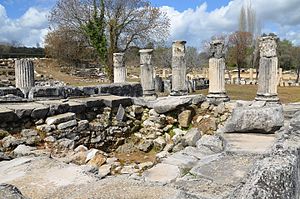Lagina

Lagina (Ancient Greek: Λάγινα) or Laginia (Λαγινία)[1] was a town in the territory of Stratonicea, in ancient Caria. It contained an important temple of Hecate, at which every year great festivals were celebrated.[2] Tacitus, when speaking of the worship of Trivia among the Stratoniceans, evidently means Hecate.[3]
Its site is located near Turgut, Asiatic Turkey.[4][5]
Recent studies have shown that the site had been inhabited and/or employed in an uninterrupted manner during a time span stretching back to the Bronze Age. Seleucid kings conducted a considerable reconstruction effort in the sacred ground of Lagina and transformed it into a foremost religious center of its time, with the nearby (at a distance of 11 kilometers) site of Stratonicea becoming the administrative center. The two sites (Lagina and Stratonikeia) were connected to each other in antiquity by a holy path.[citation needed]
The archaeological research conducted in Lagina is historically significant in that it was the first to have been done by a Turkish scientific team, under the direction of Osman Hamdi Bey and . In 1993, excavation and restoration work was resumed under the guidance of Muğla Museum, by an international team advised by Professor .[6]
The friezes of the Hecate sanctuary are displayed in the Istanbul Archaeology Museums. Four different themes are depicted in these friezes. These are, on the eastern frieze, scenes from the life of Zeus; on the western frieze, a battle between gods and giants; on the southern frieze, a gathering of Carian gods; and on the northern frieze, a battle of Amazons.[7][citation needed]
Lagina was Christianised at an early date and was the seat of a bishop; no longer a residential see, it remains a titular see of the Roman Catholic Church.[8]
References[]
| Wikimedia Commons has media related to Lagina. |
- ^ Stephanus of Byzantium. Ethnica. s.v.
- ^ Strabo. Geographica. xiv. p.660. Page numbers refer to those of Isaac Casaubon's edition.
- ^ Tacitus. Annals. 3.62.
- ^ Richard Talbert, ed. (2000). Barrington Atlas of the Greek and Roman World. Princeton University Press. p. 61, and directory notes accompanying.
- ^ Lund University. Digital Atlas of the Roman Empire.
- ^ Ministry of Culture and Tourism - Muğla
- ^ Pamela A. Webb, Hellenistic Architectural Sculpture: Figural Motifs in Western Anatolia and the Aegean Islands, (Madison WI 1996) 108-120.
- ^ Catholic Hierarchy
![]() This article incorporates text from a publication now in the public domain: Smith, William, ed. (1854–1857). "Lagina". Dictionary of Greek and Roman Geography. London: John Murray.
This article incorporates text from a publication now in the public domain: Smith, William, ed. (1854–1857). "Lagina". Dictionary of Greek and Roman Geography. London: John Murray.
Coordinates: 37°22′42″N 28°02′21″E / 37.378275°N 28.039242°E
- Ancient Greek archaeological sites in Turkey
- Populated places in ancient Caria
- Seleucid colonies in Anatolia
- Catholic titular sees in Asia
- Archaeological sites in the Aegean Region
- Holy cities
- Yatağan District
- History of Muğla Province
- Ancient Caria geography stubs
- Muğla Province geography stubs
